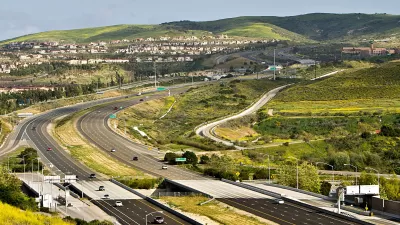Two southern CA toll roads are so severely underperforming that the state treasurer is investigating whether the bondholders can be paid their interest. The San Joaquin Hills toll road's bonds are rated at junk status. Widening I-5 & 405 didn't help.

Investors in privately-financed toll roads should first read what Dan Weikel has to write about the Transportation Corridor Agencies, "two joint powers authorities formed by the California legislature in 1986 to plan, finance, construct, and operate Orange County's toll roads" (per Wikipedia).
Orange County's great experiment in private toll roads, "touted as an innovative way to build public highways without taxpayer money", has instead shown why, perhaps, road-building should be left to the publicly-financed government sector as opposed to being financed by corporate bonds backed by tolls and development fees.
Weikel writes that "a government oversight panel chaired by state Treasurer Bill Lockyer has launched a formal inquiry into whether the roads can cover mounting interest payments to private investors who purchased tollway bonds."
"The roads, which rely on motorist tolls and fees from new developments in the area, have been battered by economic recessions, lower-than-expected population growth and competing public highways, such as Interstates 5 and 405, both of which have been widened and improved by Caltrans.
Wall Street ratings agencies have reduced the San Joaquin Hills toll road's bonds to junk status and the notes for the Foothill-Eastern corridor to the lowest investment grade."
- In 2011, ridership on the San Joaquin Hills, which has never performed as predicted, was only 43% of original forecasts, and its revenue was 61% of projections
- Motorists on the Foothill-Eastern last year numbered 33% less than projected, and revenue was 75% of forecasts
Despite the roads' sagging ridership, the agency has increased tolls repeatedly to keep pace with expenses and debt payments—at least 12 times since 1996 on the San Joaquin Hills alone.
The tolls on both corridors are now among the highest in the nation per mile. A round trip at peak travel times on the San Joaquin Hills costs $11, almost three times what it was in 1996."
Of course, another lesson may be that motorists are loath to drive on toll roads when alternative 'free roads', built, maintained, and even widened by the government are available.
To read more about how the history behind these roads, authorized by the state legislature, read the Transportation Corridor Agencies (TCA) 'about us' webpage.
Contributor's note: The TCA should not be confused with another private toll road company in California, the CPTC. From Caltrans webpage on SR 91 Express Lanes: This award winning project was developed in partnership with Caltrans by California Private Transportation Company (CPTC), an entity formed by subsidiaries of Peter Kiewit Sons', Inc., Compagnie Financiere et Industrielle des Autoroutes (Cofiroute), a French toll road company, and Granite Construction Inc.
FULL STORY: Orange County toll roads under review by California

Manufactured Crisis: Losing the Nation’s Largest Source of Unsubsidized Affordable Housing
Manufactured housing communities have long been an affordable housing option for millions of people living in the U.S., but that affordability is disappearing rapidly. How did we get here?

Americans May Be Stuck — But Why?
Americans are moving a lot less than they once did, and that is a problem. While Yoni Applebaum, in his highly-publicized article Stuck, gets the reasons badly wrong, it's still important to ask: why are we moving so much less than before?

Research Shows More Roads = More Driving
A national study shows, once again, that increasing road supply induces additional vehicle travel, particularly over the long run.

Judge Halts Enforcement of Anti-Homeless Laws in Grants Pass
The Oregon city will be barred from enforcing two ordinances that prosecute unhoused residents until it increases capacity and accessibility at designated camping sites.

Advancing Sustainability in Los Angeles County Schools
The Los Angeles County Office of Education’s Green Schools Symposium brings together educators, students, and experts to advance sustainability in schools through innovative design, climate resilience strategies, and collaborative learning.

Using Old Oil and Gas Wells for Green Energy Storage
Penn State researchers have found that repurposing abandoned oil and gas wells for geothermal-assisted compressed-air energy storage can boost efficiency, reduce environmental risks, and support clean energy and job transitions.
Urban Design for Planners 1: Software Tools
This six-course series explores essential urban design concepts using open source software and equips planners with the tools they need to participate fully in the urban design process.
Planning for Universal Design
Learn the tools for implementing Universal Design in planning regulations.
City of Moreno Valley
Institute for Housing and Urban Development Studies (IHS)
City of Grandview
Harvard GSD Executive Education
NYU Wagner Graduate School of Public Service
City of Cambridge, Maryland
Newport County Development Council: Connect Greater Newport




























